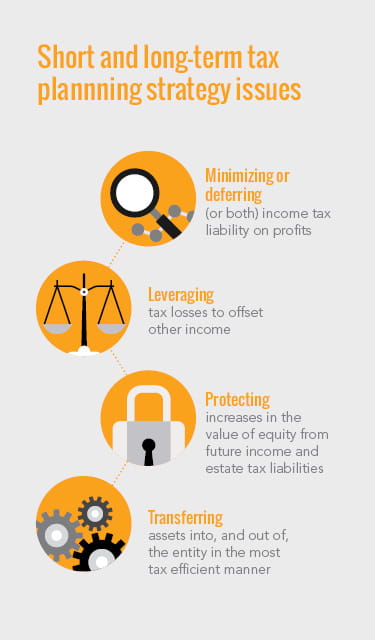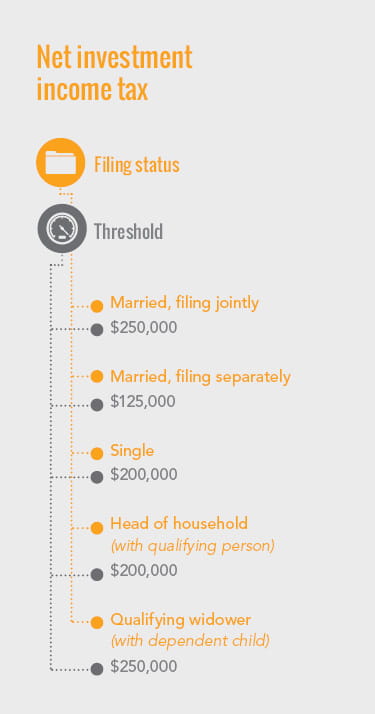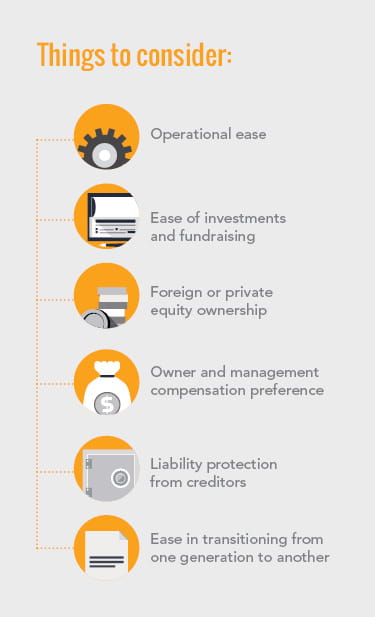When structuring their company, many franchise owners consider a number of strategic issues, such as legal liability, flexibility of ownership, investment and fundraising, and succession and exit planning, to name a few. While these remain significant concerns throughout the lifetime of a business, the tax implications for a company and its owners change as the company grows.
In some instances, a company can eliminate the tax, or at least a layer of its tax obligations; in other cases, opportunities exist to reduce or defer its tax bill. These are important concerns that can significantly impact a company’s bottom line. As such, it’s imperative to develop a tax planning strategy that considers short- and long-term issues, such as the following:

Commensurate with the consideration of the aforementioned items is the evaluation of a number of tax planning items that can help achieve those goals.
Accounting methods
Many new businesses choose cash basis accounting, rather than accrual basis. The former is generally easier to track and understand, as the company pays tax on income when it is received. Such a method is tied to cash flow without regard to accounts receivable and accounts payable, the latter which offers a more precise view of long-term financial health.As a company grows, the accrual basis may offer appealing tax advantages, allowing it to defer tax obligations. Additionally, depending on a company’s annual revenue, the IRS may require it to make the switch.
Timing is critical when making the change; you must be able to anticipate when you will reach the income threshold governing accrual accounting. And even if you fall short of that income level, recognizing what deferral opportunities exist and being able to successfully convert methodologies will minimize your tax liabilities.
Self-employment tax
Many business owners are unconcerned with the self-employment tax when they set up their company. However, as the entity grows and earnings increase, the self-employment tax can have a significant impact on the owner’s after tax returns, depending on the original business structure selected (i.e., sole proprietor or LLC).For instance, if you were an employee of a company, your paycheck would reflect a withholding amount made by your employer for Social Security and Medicare. In the meantime, your employer would be required to pay additional tax contributions toward these programs for each employee. However, if you’re self-employed, you must pay both the employer and employee portion of the tax.
Creating a separate S corporation to manage the operations of the core business could reduce the amount of self-employment tax the owner pays. The management company would pay the owner operator a salary and distributions out of its management fees received from the core business (the total could be the same as the amount you would have otherwise reported), and you would effectively pay the self-employment tax on the salary only.
It’s a straightforward strategy, but there are other considerations that you should discuss with a tax professional. For instance, the salary must be considered reasonable by industry standards. Additionally, with your salary reduced, your future Social Security benefits will also be lowered.
Net investment income tax
The net investment income tax (NIIT) became a new liability in 2013, affecting high-income individuals as well as anyone who realized a significant investment income gain. The 3.8 percent surcharge tax impacts individuals, estates, and trusts whose income exceeds certain threshold amounts.With proper planning, you can minimize the NIIT through a variety of tax planning strategies, including selling certain securities, restructuring charitable donations, and converting certain income from passive to active (see passive vs. active considerations, below).
These and other considerations have strict requirements and you should discuss their implications and implementation with a tax professional.

Passive vs. active considerations
Income is treated differently depending on whether it is classified as active or passive. There are several tests that help resolve the determination, but generally, active income is that which an individual earns for performing services and includes salaries, sales commissions, and tips; and passive income excludes income earned from active business participation, and includes earnings from a rental property, among other items.
Correctly distinguishing between the two offers substantial tax consequences, such as whether the NIIT will apply to income from an activity (see above). Additionally, because passive losses are only available to the extent that there is passive income, a taxpayer may need to defer the deduction until there is passive income.
The tax regulations are complex and have specific documentation requirements. It is critical that you seek guidance to ensure you have properly addressed the two while considering tax planning techniques.
Repair and maintenance expense regulation planning
Enacted in late 2013, the tangible property regulations change the way companies are required to treat repair and maintenance, materials and supplies, and capitalized items. The intent of the latest modifications to these regulations was to mitigate much of the ambiguity of the prior rules. Along with the increase in clarity, the new regulations provide several opportunities for companies to deduct items that they would normally capitalize. Such a relaxation offers considerable tax advantages when applied correctly.As of 2014, all companies are required to comply with the new regulations. An analysis of the numerous accounting methods and available elections can provide an opportunity to leverage the new regulations for maximum tax advantages.

Capital expenditure planning
Similar to tangible property regulations planning, capital expenditure planning affects what a company can expense or capitalize. While this might be a modest consideration for franchisors with minimal capitalized assets, for multi-unit franchisees that operate stores and on-the-ground businesses, this could be their primary tax consideration.
For 2015 and beyond, the tax law here is unsettled, as Congress has struggled with this issue for nearly a decade. As such, it is imperative to engage a tax advisor who can move quickly to leverage current opportunities.
Tax incentive planning
The government provides a number of programs that offer generous tax credits. For instance, the FICA Tip Credit is available to a restaurant whose employees receive tips, providing it with a tax credit equal to the employer-paid FICA taxes on income that exceeds the minimum wage.Incentives are continually being introduced and eliminated; consult a tax professional to better understand the incentives that may apply to your franchise.
Key employee compensation planning
A company that is considering business transition planning must assess its compensation of key employees. Commensurate with establishing a bonus program is a consideration of the timing for when the company can claim that deduction. Will it be a current deduction? Or will the bonus be deferred, delaying the tax liability?Depending on the importance of the employees and their compensation, this could create substantial balance sheet implications, which impact the company’s financial appeal to investors or would-be acquirers.





